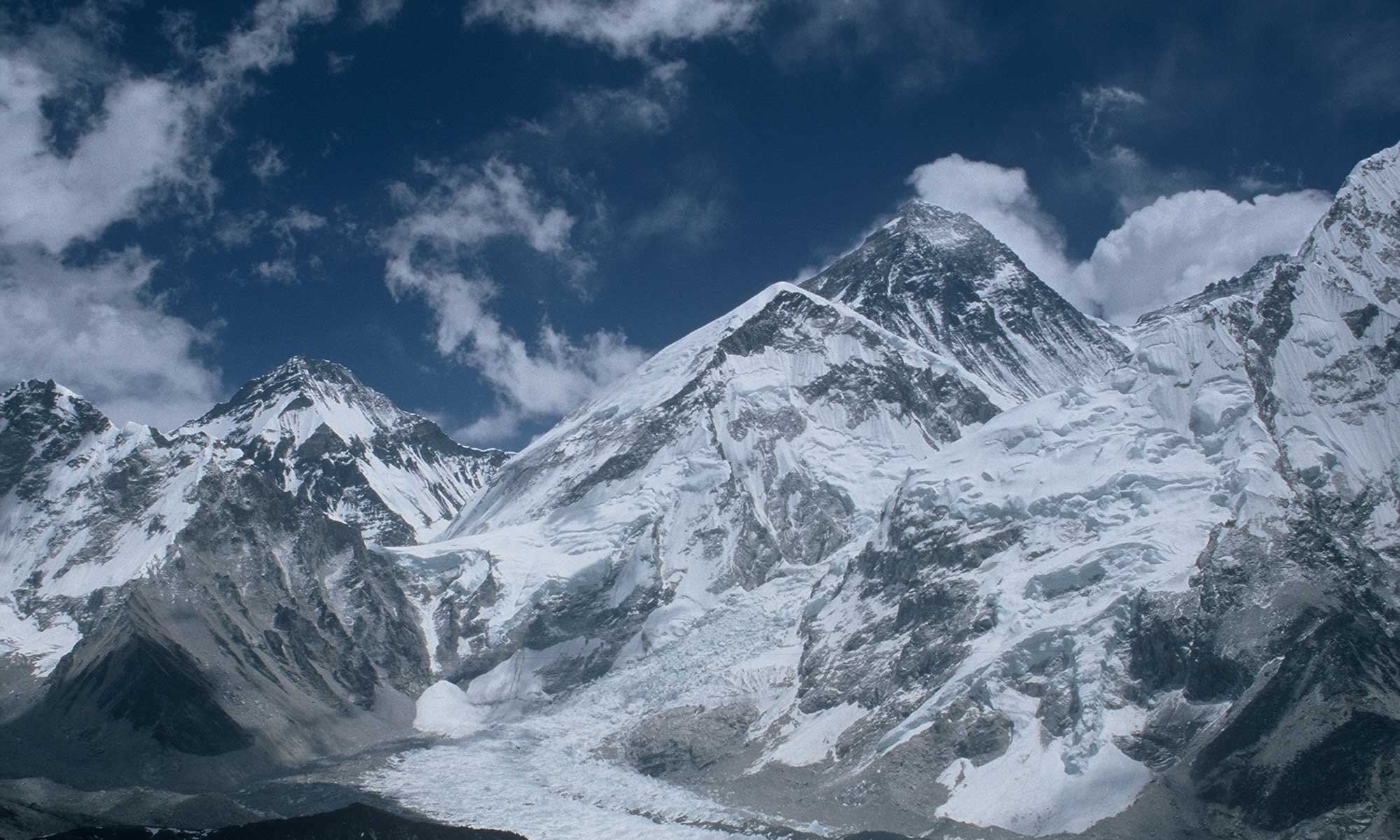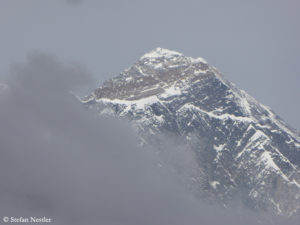As if there were no other problems on Mount Everest. For weeks, social media has been discussing a new signboard that the regional administration of the Khumbu region put up at the entrance to Everest Base Camp before the start of this year’s climbing season – directly in front of the boulder marked with paint that has served as a photo motif in recent years. There’s no accounting for taste – on both counts. The new sign shows Everest and in front of it Sir Edmund Hillary and Tenzing Norgay, who were the first people to scale the highest mountain on earth in 1953. Only one member of that expedition team is still alive: Kanchha Sherpa, now 91 years old.
I spoke to his grandson Tenzing Chogyal Sherpa – not about the new sign at Everest Base Camp, but about the consequences of climate change for the Everest region. The winter of 2023/2024 – like the previous one – was exceptionally warm and dry. Tenzing is a glaciologist at the International Centre for Integrated Mountain Development (ICIMOD) and works on the cryosphere, in simple terms everything to do with snow, ice and permafrost on Earth. The research of the 31-year-old scientist from Nepal focuses on the glaciers and glacial lakes in the mountainous regions of Asia.
Tenzing, you are the grandson of Kanchha Sherpa, the last surviving mountaineer from the 1953 expedition that first climbed Mount Everest. What does your grandfather think about the commercial mountaineering that is common today on the highest mountain on earth?
I asked him the same question lately. He feels that, of course, the local people benefited from the exponential growth of mountain tourism after 1953, our income has increased a lot. But despite of that he also feels that we are defiling the sanctuary of Everest or, as we say, Chomolungma. The mountain is sacred and the people pollute it. So he feels that the mountain should be given some rest with a more sustainable approach because many people depend on that mountain. We should respect it. It should be given a balance, because if we don’t do this, the goddess will get angry at the people. Many are losing their lives in avalanches. The mountain is getting more and more dynamic.
Do you two also talk about the changes on Everest due to climate change?
Yes, we do talk about it as well. Especially because he is the eldest member from our whole village. So he embodies the history of mountaineering and our village itself. He is very aware of all these changes in the environment. He realizes that nowadays there are fewer snowy days as it used to be. And he also understands that this is not necessarily good for the environment. Because if people didn’t have enough snowfall during winter in the past, there wouldn’t be enough crop production in the coming season.
In January and February Nangpa La (5806 m) and Nup La (5844), two high passes near the eight-thousander Cho Oyu, were free of snow. Do you think it’s an alarm signal for climate change?

I wouldn’t say directly alarming because snowfall is dynamic and can differ. But in a way it is concerning. The data show that the number of snowy days, the amount of snow and the snow cover are decreasing. There is a negative trend. This kind of naked passes and mountains visualize what happens.
You were a member of the National Geographic science expedition on Mount Everest that installed weather stations up to the „Balcony“ at 8,430 meters in 2019. Last meteorological winter was an extremely dry one in the Everest region. Have the people to get used to very dry winters due to climate change?
We have more and more dry winters. And we have unseasonal precipitation. We have snowfall when we don’t need it. The weather stations on Everest were installed five years ago. It’s too soon to talk about trends. We don’t have continuous long-term data. If we want to look at climate change we need at least 30 years of data. Regardless, this kind of specific dry events is quite concerning. The people in the mountains are more and more aware that this might be due to climate change and they try to adapt accordingly.
As a glaciologist, you have studied the Khumbu Glacier. What is your future scenario for this glacier, including the Khumbu Icefall?
The Khumbu Glacier, which stretches down to the village of Lobuche is covered with debris. There a lot of boulders lying on the ice. The glacier has not yet retreated massively, but it is slowly thinning out – in sixty years there was a maximal thinning of around 80 meters near Everest Base Camp. If you look at pictures of the Khumbu Glacier, you see now a lot of small ponds forming. They can emerge to a larger lake like the Imja Glacial Lake in the neighboring valley. And the naturals dams of these glacial lakes can burst in the future.

Regarding the Khumbu Icefall, we notice a lot of retreat at steep points. In a longer-term future we might see that the upper part of the Khumbu Glacier is disconnected from the lower part. This has already been noticed in many glaciers in other regions, such as Langtang. In this case, the lower part of the glacier turns into dead ice.
You have researched the phenomenon of dangerous glacial lakes in the Himalayas. Do you think the danger is manageable?
This is a difficult question. It was also an issue that one of our religious leaders, the head of Tengboche Monastery, talked about. He said: “Don’t try to play God, don’t try to mingle in things you cannot control!” We can only manage the glacial lakes up to a certain point. We can try to minimize the hazards – for example by building high walls to prevent villages from being flooded. We can ask people to stay away from the most dangerous areas. It’s about adapting and building resilience so that the people are prepared in the event of such a hazard and expose themselves to minimal risk. It’s a difficult and financially intensive task. But in the end we want to try to save the people, their livelihood and to minimize the risk.
You grew up in Namche Bazaar, your family lives in the Khumbu. Do you feel that the local population has realized the dangers of climate change for their region and is taking them seriously enough?

Sherpa life is depending on these kind of weather changes. There are three occupations in which most of them work: mountaineering, tourism industry and agriculture. All of them depend on the weather. There has been a lot research on climate change in the region, a lot of scientists are coming in to interact with them. So the local people are very aware of what’s going on. They actually want to do something themselves. And they want their government to do something .
What do you as a scientist on the one side and a young man from the Khumbu on the other side hope for from the decision-makers in politics when it comes to climate protection?
There is a gap of what scientists can say, what local people understand and what in the end the politicians make of it. The main thing is to close this gap. Maybe then we’ll have a more inclusive and a more bottom-to-top policy that makes the right decisions that are needed.
Let’s come back to mountaineering. What was the highest point you reached?
I am not a mountaineer but I do study the mountains from near and far. The highest I have been up to was 6,000 meters. But that was more glacier walking than climbing.
So you are not tempted to climb Mount Everest yourself?
No. My grandpa used to be away on expeditions for three, four months a year. My grandma was the only women in house. She lost two children, when her husband was not at home. In 1972, there was an avalanche that led to the death of many people in the village that my Grandpa and Grandma knew. That caused my Grandma to say: „Don’t go to the mountains, you can do other things like trekking!“ Nobody in my family should go to the mountains anymore. That’s why the next generation of my father and others focused more on education, because education is the way we open the door to other professions. I respect mountaineering and I like to see people going to these adventures but from the family perspective it’s quite dangerous. And I am fine with studying the mountains and looking to them from far. They look very beautiful, also from far.




Excellent interview, thanks.